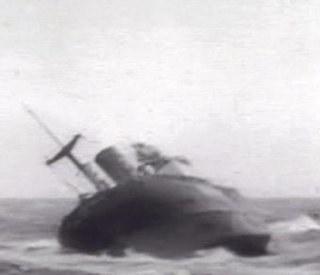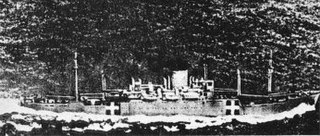
MV Virginian, formerly named the MV Strong Virginian (T-AKR-9205), is a combination container, heavy lift, and roll-on/roll-off ship. Owned and operated by Sealift Incorporated of Oyster Bay, New York, the ship is one of seventeen container—roll-on/roll-off ships in use by the Military Sealift Command, and one of 28 ships assigned to that organization's Sealift Program Office. The ship was previously known as the MV Saint Magnus and the MV Jolly Indaco.

USS Gettysburg (CG-64) is a Ticonderoga-class guided-missile cruiser in the United States Navy. She is named for the Battle of Gettysburg during the American Civil War.

Suomen Joutsen is a steel-hulled full-rigged ship with three square rigged masts. Built in 1902 by Chantiers de Penhoët in St. Nazaire, France, as Laënnec, the ship served two French owners before she was sold to German interest in 1922 and renamed Oldenburg. In 1930, she was acquired by the Government of Finland, refitted to serve as a school ship for the Finnish Navy and given her current name. Suomen Joutsen made eight long international voyages before the Second World War and later served in various support and supply roles during the war. From 1961 on she served as a stationary seamen's school for the Finnish Merchant Navy. In 1991, Suomen Joutsen was donated to the city of Turku and became a museum ship moored next to Forum Marinum.

ARA Bahía Buen Suceso (B-6) was a Bahía Aguirre-class 5,000-ton fleet transport that served in the Argentine Navy from 1950 to 1982. She took part in the Falklands War as a logistics ship tasked with resupplying the Argentine garrisons scattered around the Falkland Islands. Captured by British forces on 15 June after running aground at Fox Bay, she sank in deep waters while being used as target practice by the Royal Navy on 21 October 1982.

SS Flying Enterprise was a 6,711 ton Type C1-B ship which sank off Cornwall in 1952. She was built in 1944 as SS Cape Kumukaki for the United States Maritime Commission for use in World War II. The ship was sold in 1947 and then operated in scheduled service under the name Flying Enterprise.

German submarine U-75 was a Type VIIB U-boat of Nazi Germany's Kriegsmarine during World War II. U-75 was moderately successful in her early career in the Battle of the Atlantic, but in autumn 1941 she was dispatched to the Mediterranean Sea with poor results, leading to the eventual destruction of the boat and her crew.

The Cöln class of light cruisers was Germany's last class commissioned before her defeat in World War I. Originally planned to comprise ten ships, only two were completed; Cöln and Dresden. Five more were launched, but not completed: Wiesbaden, Magdeburg, Leipzig, Rostock and Frauenlob, while another three were laid down but not launched: Ersatz Cöln, Ersatz Emden and Ersatz Karlsruhe. The design was a slightly modified version of the preceding Königsberg class.

A heavy-lift ship is a vessel designed to move very large loads that cannot be handled by normal ships. They are of two types:

The Grimaldi Group is a private shipping company owned by the Grimaldi family and based in Naples, Italy. Grimaldi operates a large fleet of ro-ro, ro-ro/multipurpose, con-ro multipurpose, PCTC, ro-pax and cruise ferries vessels.

MV Rocknes was a 166-metre (545 ft)-long rock discharge vessel that hit shallow water and suddenly capsized south of Bergen, Norway on 19 January 2004, killing 18 members of its 30-person crew. At the time of its sinking, it was the world's largest dynamically positioned flexible fall pipe rock dumping vessel. The ship was repaired during 2004 and 2005 and renamed Nordnes.
Domala was an 8,441-ton cargo liner which was built in 1920 and launched as Magnava. Following damage sustained in an air attack in 1940, she was rebuilt as a cargo ship and renamed Empire Attendant. In 1942 she was torpedoed and sunk with the loss of all crew.

The Awa Maru (阿波丸) was a Japanese ocean liner owned by Nippon Yusen Kaisha. The ship was built in 1941–1943 by Mitsubishi Shipbuilding & Engineering Co. at Nagasaki, Japan. The vessel was designed for passenger service, but the onset of war by the time work was completed changed requirements, and she was requisitioned by the Japanese Navy. While sailing as a relief ship under Red Cross auspices in 1945, she was torpedoed by USS Queenfish (SS-393), resulting in the death of all but one of the 2,004 people aboard.
TS Pretoria was a ship that had a long and varied career as first a German cargo liner, then a U-boat depot ship, hospital ship, British troop ship, Muslim pilgrim ship and finally an Indonesian naval accommodation ship.

MV Paul R. Tregurtha is a Great Lakes-based bulk carrier freighter. She is the current Queen of the Lakes, an unofficial but widely recognized title given to the longest vessel active on the Great Lakes. Launched as MV William J. De Lancey, she was the last of the thirteen "thousand footers" to enter service on the Great Lakes, and was also the last Great Lakes vessel built at the American Ship Building Company yard in Lorain, Ohio. The MV Paul R. Tregurtha is the current flagship for the Interlake Steamship Company.

MV Ramsey was a coastal cargo vessel built for the Isle of Man Steam Packet Company in 1964. She was the last vessel specially built to serve the smaller ports of the Island.

Typhoon Orchid, known in the Philippines as Typhoon Toyang, was a deadly typhoon that formed during the 1980 Pacific typhoon season. The monsoon trough spawned a tropical depression on September 1. It tracked northwestward, remaining disorganized and dissipating on the 5th. Another tropical depression developed to the east of the old circulation, quickly becoming the primary circulation and intensifying to a tropical storm on the 6th. With generally weak steering currents, Orchid looped three times on its track, strengthening to a typhoon on the 9th and reaching a peak of 95 mph winds on the 10th. Early on the 11th the storm hit southwestern Japan, and became extratropical that day over the Japan Sea.

MV Struma was a small ship with a long history that included a number of changes of use and many changes of name. She was built in 1867 as a British marquess's luxury steam yacht and ended up 75 years later as a Greek and Bulgarian diesel ship for carrying livestock. She was launched as Xantha, but subsequently carried the names Sölyst, Sea Maid, Kafireus, Esperos, Makedoniya and finally Struma.
SS London Valour was a British merchant ship belonging to London & Overseas Freighters (LOF). She was built as an oil tanker in England in 1956 and converted into a bulk carrier in Italy in 1966. She was wrecked in a gale just outside the Port of Genoa in 1970, resulting in the deaths of 20 of the 58 people aboard.
Cockaponset was a steam cargo ship built in 1918–1919 by Pacific Coast Shipbuilding Company of Bay Point for the United States Shipping Board as part of the wartime shipbuilding program of the Emergency Fleet Corporation (EFC) to restore the nation's Merchant Marine. The vessel was largely employed on the Gulf Coast of the United States to Europe route until 1930 when she was laid up. In late 1940 the ship together with 15 other vessels was acquired by the British government to alleviate significant shortage of tonnage due to an ongoing German U-boat campaign. In May 1941 the freighter was torpedoed and sunk on her first war trip to the United Kingdom.

On 24 October 2023, one person was killed and four others disappeared after two cargo ships, the Isle of Man-flagged Verity and the Bahamian-flagged Polesie, collided in the North Sea near Germany's Heligoland islands, with the Verity sinking.
















